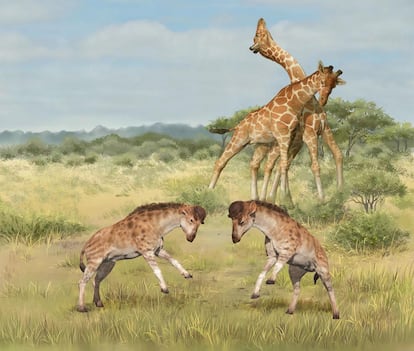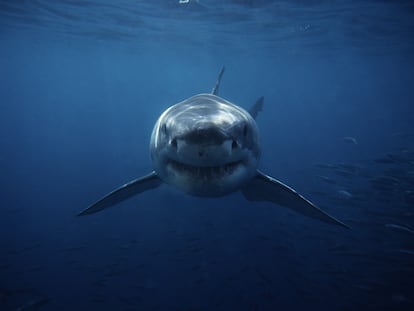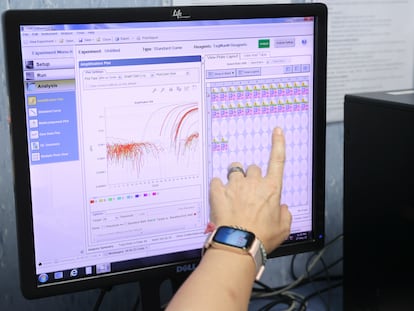Giraffes’ necks may have evolved for sexual competition
Head-butting between males caused the feature to elongate, according to analysis of fossils from a newly discovered ‘giraffoid’ species

At almost six meters, giraffes (Giraffa camelopardalis) are the tallest land animals among living species. The classic explanation for the long neck is that competition for food would have favored tall animals who could reach leaves that other herbivores could not. Now, the discovery of a fossil of a close relative of the G. camelopardalis reinforces another, previously marginal hypothesis: sexual selection. The males of this species had a unique head and neck morphology that they used to headbutt each other when competing for females. The scientists who discovered it believe that this distant ancestor’s extreme behavior could explain giraffes’ evolution.
Giraffes’ long necks have been an evolutionary mystery for centuries. Although different hypotheses exist about the evolutionary process, scientists have long agreed that it had to do with reaching high leaves on trees. The two pioneers of evolution, the Frenchman Jean-Baptiste Lamarck and the Englishman Charles Darwin, used the animal to explain how species evolved. At the beginning of the 19th century, Lamarck argued that giraffes, in their eagerness to reach the highest leaves, lengthened their necks generation after generation. Years later, Darwin turned the theory around: some giraffes in each generation would have longer necks, giving them an adaptive advantage for reproductive success, so that, in the long run, they would all have long necks.
But scientists have now formulated an alternative to that classic explanation: the creature’s long, elegant neck actually serves as a weapon in the male courtship competition. This could be the key to the mystery of giraffe evolution. Specifically, they could use their two- to three-meter-long necks to attack with their heads, which feature skin-covered bony protrusions called ossicones. The protrusions’ impact on rivals can cause serious injuries and even death. The advantage is clear: the longer the neck, the greater the damage.
The hypothesis has new evidence after the discovery of a close relative of giraffes that lived about 17 million years ago in the Junggar basin in northwest China. Scientists have named the species Discokeryx xiezhi, after the words for disk-horn and an homage to the xiezhi, a horned figure from Chinese mythology. In the case of this giraphoid–which is not a direct ancestor of giraffes–the most striking feature is a kind of disc-shaped helmet or beret in the center of the head. Formed by the hardening of the keratin of the skin, it was a structure that males use to headbutt each other in fights. The authors of the study, recently published in Science, write that “The D. xiezhi was able to exhibit the most ferocious behavior among all ruminants.”
The authors of the study analyzed the creature’s anatomy to understand the mechanics of the headbutting practice. They first examined the fossil’s cervical vertebrae, the thick skull bones, the intervertebral joints and the atlanto-occipital joint, which connects the head and the spine and allows for mobility. Then they compared those features with three current-day ruminant species with particularly strong bones: the musk ox, the blue sheep and the mouflon. After conducting a series of experiments, they concluded that the D. xiezhi had one to five times as much resistance and energy absorption capacity than other animals with similar defensive features on their heads.
But what do D. xiezhi’s headbutts have to do with the neck of the G. camelopardalis? Shi-Qi Wang, a researcher at the Institute of Vertebrate Paleontology and Paleoanthropology of the Chinese Academy of Sciences and lead author of the study, explains: “Both current giraffes and Discokeryx xiezhi belong to the Giraffoidea superfamily. Although their skull and neck morphology are very different, both are related to male courtship fighting.”
To reinforce their thesis, the authors analyzed the morphology of known giraffes, the two existing ones (giraffe and okapi) and more than a dozen extinct species. Wang and colleagues show that giraffes and their close relatives have greater variety than other ruminants: they can have, for example, 14 different types of hooves. In comparison, bovids (goats, mouflons, antelopes and bulls) have only five different kinds of horns, and cervids (deer, elk and moose) have only nine different horn structures. The wide genetic variety suggests that giraffes have a genetic plasticity that other ruminants lack.
Rob Simmons is a researcher at the University of Cape Town, South Africa. He has spent years defending the thesis of sexual selective pressure. “You have to keep in mind that it has been very difficult for traditional giraffe researchers to accept the idea that sexual selection played a role in the shape and length of their necks.” Simmons, who was not involved in Wang’s study, argues that “this analysis opens that door, showing that if the morphology of ancestral giraffes can be explained by sexual selection, then that of the modern giraffe can be explained by the same idea.”
Simmons, along with his colleague R. Altwegg, reviewed all the hypotheses about the neck of giraffes in a paper published a few years ago. “We saw that we cannot easily distinguish them,” he explains in an email. Why? “Because the evolution of a morphological trait consists of two parts: (i) the incipient stages that promoted the evolution (a change of climate, of competitors/predators, a sudden mutation that allowed new paths...) and (ii) the trait maintenance. Current evidence can easily show how the trait is maintained, and some experiments [...] show that the giraffe can outcompete other folivores when feeding on tall trees.” But his own research points in the other direction. “It’s not just that longer-necked males are chosen by receptive females to mate with, but they show allometric growth [relative changes in one body part to the whole] in their necks (four kg of muscle per year) and in their heads (one kg of bone per year) and the females do not. They stop growing when they reach sexual maturity. This is what the theory of sexual selection predicts,” he concludes.
Another common question remains to be answered: if competition between males is the reason for long necks, why do females also have the trait? Ted Stankowich of California State University, Long Beach explains that “there are a few reasons why females may carry cranial defenses–antlers or horns–that evolved primarily for sexual combat between males. In bovids, females have horns in species that are more visually exposed to predators. They are also found in species where the females participate in the active defense of the territory,” he says. As for giraffes, “this may be valid if the females also defend territories from other females or if they use them to defend themselves against predators.” The group from which the current giraffe originates emerged about six million years ago when large areas of the African jungles had become savannahs, with all the dangers posed by open spaces.
This does not mean that the theory about selective pressure to reach high leaves is wrong. Wang, the main author of the study of the D. xiezhi, says, “I think both male-male fighting and foraging played a role in neck elongation, but in different ways. Okapi [the giraffe’s closest relative] also fight with their short necks, but not as fiercely as giraffes. The ancestor of the giraffe was similar to the Okapi, both in neck morphology and fighting style. The ancient giraffe left the forests and entered the savannah grasslands. Males might have fought using their necks more and more fiercely, getting longer and longer. It eventually became the giraffe it is today and was able to reach the highest leaves.”
Simmons, from the South African university, sums up the debate: “What we don’t know is what started this whole process. Did an ancestor of the giraffe start fighting with its shorter neck and develop longer, stronger necks from there, or did the expansion of grasslands in the Pliocene reduce the ability of short-necked ancestors to reach trees, and only the tallest and longest-necked animals could survive the food shortage?” He concludes by remembering Darwin: “The great teacher and grandfather of the theory of evolution, Charles Darwin, said these wise words more than 100 years ago: The preservation of each species [or trait] can rarely be decided by one advantage, but by the union of all, large and small.”
Tu suscripción se está usando en otro dispositivo
¿Quieres añadir otro usuario a tu suscripción?
Si continúas leyendo en este dispositivo, no se podrá leer en el otro.
FlechaTu suscripción se está usando en otro dispositivo y solo puedes acceder a EL PAÍS desde un dispositivo a la vez.
Si quieres compartir tu cuenta, cambia tu suscripción a la modalidad Premium, así podrás añadir otro usuario. Cada uno accederá con su propia cuenta de email, lo que os permitirá personalizar vuestra experiencia en EL PAÍS.
¿Tienes una suscripción de empresa? Accede aquí para contratar más cuentas.
En el caso de no saber quién está usando tu cuenta, te recomendamos cambiar tu contraseña aquí.
Si decides continuar compartiendo tu cuenta, este mensaje se mostrará en tu dispositivo y en el de la otra persona que está usando tu cuenta de forma indefinida, afectando a tu experiencia de lectura. Puedes consultar aquí los términos y condiciones de la suscripción digital.
More information
Últimas noticias
Most viewed
- Charles Dubouloz, mountaineering star, retires at 36 with a farewell tour inspired by Walter Bonatti
- The Florida Keys tourist paradise is besieged by immigration agents: ‘We’ve never seen anything like this’
- CBS in crisis after pulling a report on Trump’s deportations to El Salvador (which later leaked online)
- Chevy Chase, the beloved comedian who was a monster off camera: ‘Not everyone hated him, just the people who’ve worked with him’
- From Gwen Stefani to Katy Perry: The MAGA drift of celebrity Democrats











































